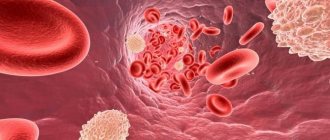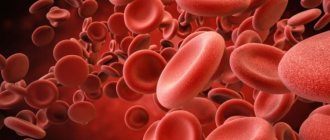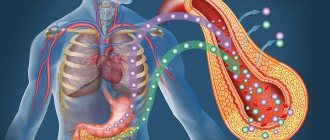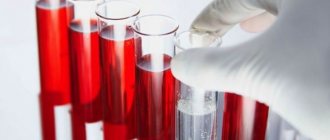Do not self-medicate. At the first signs of illness, consult a doctor.
The average volume of red blood cells can be either reduced or increased, which very often has a pathological basis. Only certain physiological circumstances lead to such a disorder.
Any changes in the average volume (below or above normal) lead to the expression of some clinical signs, but they can be masked as symptoms of the underlying disorder. The main symptoms are weakness and constant drowsiness, pale skin and decreased blood pressure.
The average volume of red blood cells in the blood is determined only after the hematologist deciphers the data from a general analysis of this biological fluid. To identify the causes of deviations from the norm, a comprehensive examination of the patient will be required.
Correction of this parameter is achieved using conservative means, however, it is not possible to completely get rid of the problem without neutralizing the underlying disease.
Normal values
The average volume of red blood cells normally depends on several parameters, namely: the gender and age category of the person. The units of measurement for this value are femtoliters (fl) or cubic micrometers (µm^3).
| Age | Norm (fl) |
| First week of life | 88-126 |
| 1 month | 88-124 |
| 2 months | 77-115 |
| 3-6 months | 77-108 |
| 1-5 years | 73-85 |
| 5-10 years | 75-87 |
| 10-15 years | 76-95 |
| Girls (15-18 years old) | 78-98 |
| Boys (15-18 years old) | 79-95 |
| Women (18-45 years old) | 81-100 |
| Men (18-45 years old) | 80-99 |
| Adults from 45 to 65 years old | 81-101 |
| Older women | 81-102 |
| Older men | 81-103 |
It is very important to consider that in a child under the age of 10 years, such an index may fluctuate slightly in any direction, which is considered quite normal. Most often, the parameter stabilizes and coincides with the above values by the age of 15.
Reduced RDW pathology and norm
In a healthy person, red blood cells have the same shape, density and color. In cases of deviations, especially in autoimmune diseases and oncology, a malfunction occurs at the microcellular level when newly formed cells do not receive enough of certain components, and in fact are not able to perform their functions. This leads to anemia, a pathological condition in which the body does not receive the required amount of oxygen, that is, the metabolic function of red blood cells is disrupted.
The erythrocyte distribution index is determined during a general blood test. In some cases, if a specific disease is suspected, only this index can be determined in the analysis. In most cases, the RDW is determined together with the average MCV volume, since these indices (volume and quantity) are interrelated and help determine the type of anemia. The fact is that for a complete assessment of the condition of red blood cells, not only their shape is important, but also the quantity in the blood. And if elevated values occur with a frequency of 1 in 10,000 people, then decreased values occur extremely rarely and always indicate serious health problems.
A blood test to determine RDW can be performed both routinely (during medical examinations) and according to indications when there are suspicions of abnormalities in hematopoietic function. The analysis is mandatory before surgery, in childhood and during pregnancy.
Why is RDW needed?
As mentioned above, this index allows you to evaluate the qualitative composition of red blood cells, taking into account their dimensions.
But what does this give? The fact is that red blood cells are similar to each other, like twin brothers, which allows them to replace each other at the right time or stick together into blastulas. If cells increase in size, their need for nutrition also increases, and accordingly their life expectancy is short. This in turn affects the overall level of red blood cells in the blood and human health.
The more cells die, the more bilirubin and iron are released, which in turn places an increased burden on the liver, which will malfunction and cannot cope with the processing of these substances.
The RDW index is directly related to anisocytosis, a pathological process in which the shape of red blood cells changes, which affects their volume and size. Anisocytosis is a complex chemical process that affects all blood cells.
We invite you to watch a video on the topic
How is it determined?
The erythrocyte distribution index is calculated as a percentage, the norm of which varies from 11.5 to 14.8.
It is determined using a mathematical formula, in the form of the ratio of modified red blood cells exceeding the maximum permissible volumes to the total mass of red blood cells.
Today, laboratories use computer technology to determine the percentage of deviation from the norm without manual calculations. The output data is presented in the form of a histogram, which displays a curve indicating possible modifications of red blood cells.
What do the results depend on?
Norms are determined depending on age, gender and the presence of physiological processes occurring in the body. For children in the first year of life, the norm is considered to be 11.5-18.7%. After a year, the digital values tend to the generally accepted norm - 11.5-14.5%. In women, the upper limit may shift to 15.5%, which is explained by frequent changes in hormonal levels: pregnancy, breastfeeding, taking hormonal contraceptives, menopause.
Blood is taken in the morning (before 9 am) on an empty stomach
It is important that before blood sampling the person does not take any medications and is in a balanced state
Index Variations
For a more detailed in-depth study of the erythrocyte distribution index, two values are considered:
- RDW-SD - determines the standard deviation from the norm, expressed in femtoliters. The indicator is in no way related to MCV, since it shows the quantitative value of the difference between the largest and smallest cells.
- RDW-SV - shows how much the volume of red blood cells differs from the average. It is defined as the percentage of all deformed cells to the total red blood cell mass.
Reasons for deviations from the norm
The average volume of red blood cells in children or adults may fluctuate up or down, which in any case indicates the occurrence of some pathological process.
For example, when the mean red blood cell volume is elevated, a person may be diagnosed with one of the following:
- severe poisoning from chemicals or poor-quality food;
- thyroid dysfunction and other pathologies of the endocrine system;
- deficiency of iodine or iron in the body;
- reticulocytosis;
- liver pathologies, in particular hepatitis and cirrhosis;
- cancer of the bone marrow;
- celiac disease;
- DiGuglielmo's disease;
- hypothyroidism;
- hyperglycemia;
- infection or inflammation in the pancreas;
- myelodysplastic syndrome;
- chronic liver failure.
If mcv is elevated, then this does not always indicate the course of the disease, for example, among the less harmless sources are:
- sedentary lifestyle;
- poor nutrition;
- uncontrolled use of medications;
- long-term addiction to bad habits;
- specific working conditions, for example, under which a person is forced to constantly come into contact with toxins;
- hormonal imbalance that develops during menstruation or pregnancy.
If a general clinical blood test shows that the average volume of red blood cells is reduced, this may indicate:
- various types of anemia;
- formation of malignant neoplasms;
- heavy metal intoxication;
- thalassemia;
- leukemia;
- heavy blood loss;
- metastasis of malignant tumors;
- porphyria;
- autoimmune diseases.
Also, the indicator can be reduced due to abuse of the following medications:
- "Isoniazid";
- "Colchicine";
- "Metformin";
- "Phenacetin";
- "Trimethoprim";
- "Methotrexate";
- "Pyrimethamine";
- "Triamterene";
- "Glutethimide";
- mefenamic acid;
- estrogens;
- oral contraceptives;
- nitrofurans;
- anticonvulsants;
- aminosalicylic acid.

Drug Isoniazid
In some situations, the average volume of red blood cells mcv remains within the normal range, but a person may experience:
- normocytic anemia;
- hemoglobinopathy;
- pathologies of the hematopoietic system;
- hypogonadism;
- hypopituitarism;
- hypoadrenalism;
- hypothyroidism;
- chronic infectious processes;
- uremia.
Indications for analysis
MCV blood test is not the only one. To clarify the diagnosis, the therapist may require a retake or refer it for additional tests.
MCV is informative in two cases:
- in order to diagnose one of the types of anemia;
- to determine the type of water-salt imbalance. People are often sent for such an analysis if they have various intestinal infections, acute respiratory diseases and ARVI.
Other, no less serious, reasons for getting tested may be:
- failure of the hormonal system;
- metabolic problems;
- overweight;
- increased blood sugar or diabetes;
- a sharp and causeless decrease in the level of the immune system.
MCV analysis results often help identify such deviations:
- anemia of normochromic type. It is fixed when pathologies appear in the bone marrow, sometimes caused by chronic diseases;
- macrocytic type anemia. It is characterized by an excessive increase in mcv. Red blood cells increase in size due to insufficient amounts of vitamin B and folic acid;
- microcytic anemia. In this case, the disease occurs due to a lack of iron in the blood.
Symptoms
Since the average volume of red blood cells in a child or an adult can decrease and increase, any deviation will have characteristic external manifestations. However, they can go completely unnoticed by a person or be masked by the symptoms of the underlying pathology.
If the volume is increased, this may be indicated by:
- excessive pallor of the skin and lips;
- frequent occurrence of pain in the abdominal area;
- increased heart rate;
- yellowness of the skin of varying degrees of severity;
- aversion to food;
- severe weakness and fatigue.
When the average red blood cell volume is low, a person may complain of:
- constant drowsiness;
- significant decrease in performance;
- cold sweat;
- cold skin;
- decreased blood tone;
- lethargy and slowness of movements;
- fainting state;
- increased heart rate;
- emotional insufficiency.
Such external manifestations should be an impetus for immediately seeking qualified help. It is worth noting that in children some symptoms may be much more pronounced than in adults.
Diagnostics
The volume of red blood cells is assessed during a general clinical analysis of the main biological fluid of the human body. For such a study, venous or capillary blood may be needed.
As for preparation for the analysis, it is limited to refusing to eat on the day of visiting the medical facility. Otherwise, the results will be false, which may require repeat blood donation.
In situations where the analysis showed that mcv is low or above normal, the provocateur of such changes should be identified. This will require a comprehensive examination of the body, which is individual in nature.
Primary diagnostic measures, common to all, are:
- familiarization with the medical history;
- collection and analysis of life or family history;
- assessment of the condition of the skin;
- measurement of blood tone and heart rate values;
- a detailed survey of the patient so that the clinician obtains a complete picture regarding the course of a particular disorder.
In addition, the following may be prescribed:
- specific laboratory tests;
- a wide range of instrumental procedures;
- consultations with specialists from various fields of medicine.
Elevated red blood cell levels in an adult
Red blood cells are blood cells responsible for delivering oxygen molecules to cells and removing the metabolic product, carbon dioxide. The lifespan of a cell is about 3 months. Then the blood elements are destroyed in the liver and excreted from the body, and they are replaced by young cells synthesized in the bone hematopoietic germ. Male and female erythrocyte level standards are slightly different:
- in an adult male, the concentration of erythrocytes will be 3.3-5.5*1012 units/ml;
- for a woman, the normal erythrocyte count is 3-4.7*1012 units/ml.
Higher reference values for representatives of the stronger sex are due to the fact that the male body has large muscle mass, which requires an active supply of oxygen. Androgen hormones, synthesized by the male body, stimulate the production of red blood cells.
The amount of red elements in the blood of an adult is higher than normal and requires medical consultation. The appearance of erythrocytosis indicates possible health problems.
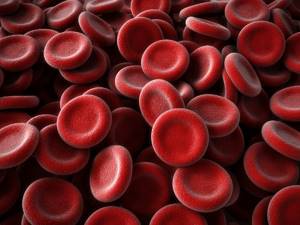
Red blood cells - erythrocytes
What does it mean?
Doctors determine what an increase in red blood cells in the blood of an adult means, taking into account an analysis of the characteristics of life and the possible influence of external factors. A slight increase is due to physiological processes:
- living in high mountain areas;
- intense sports activities.
A moderately increased number of red blood cells in an adult without signs of a general deterioration in health indicates that the body strives to compensate for the resulting oxygen deficiency caused by external factors. False erythrocytosis, when red elements are increased in 1 ml of blood with fluid loss. This happens in diseases accompanied by prolonged fever, diarrhea and vomiting.
But more often, the reasons why the erythrocyte count in an adult is elevated are pathological. They provoke deviations in the composition of the blood:
- respiratory diseases accompanied by the development of respiratory failure (COPD, asthma, tuberculosis);
- heart defects;
- kidney and/or liver disease;
- tumors.
Another common reason why the amount of red elements increases in men and women is smoking.
Due to nicotine, the smoker's body experiences oxygen starvation, and this leads to an increase in the synthesis of red blood cells. Erythrocytosis, caused by pathological factors, is accompanied by weakness, increased fatigue, dizziness and other signs of deterioration of health. When there are a lot of red blood cells in a blood test: doctors determine what this means, taking into account all the data from the patient’s examination. This allows us to identify the cause of erythrocytosis.
How to downgrade?
Having independently examined the form from the laboratory and discovered signs of erythrocytosis, there is no need to panic and search the Internet for how to lower the erythrocyte concentration. When red blood cells are elevated in a blood test in adults: what does this mean, the doctor decides.
Some conditions are considered a natural adaptive reaction to external conditions (living in the mountains, intense training) and do not require correction. When red blood cells are elevated due to fluid loss, it is necessary to replenish the lack of moisture by drinking plenty of fluids. In case of severe dehydration, an infusion of glucose and saline solutions is prescribed.
The selection of medications depends on the disease that caused the increase in erythrocyte count. To reduce viscosity use:
- Bleeding. In a hospital setting, 200-300 ml of red liquid is taken from the vein of an adult patient, and then donor plasma or saline is infused.
- Hirudotherapy. When the erythrocyte count is moderately elevated, leeches can be used to thin the blood.
- Oxygen inhalations. If an increase in the synthesis of blood cells has become a compensatory reaction in response to the development of tissue hypoxia due to smoking or respiratory failure, then oxygen therapy will slow down the production of blood elements. When smoking, it is recommended to quit the bad habit.
There are no special medications to eliminate the pathological increase in erythrocyte levels in adults. Patients are prescribed symptomatic therapy to prevent blood clots and blood thinning.
Treatment
The normal average volume of red blood cells can be restored only after the underlying disorder has been eliminated. In some cases, for correction it is enough:
- to refuse from bad habits;
- reconsider food preferences;
- Do not take medications for no apparent reason or without a doctor’s prescription.
In other situations, you should completely get rid of the underlying disorder, which can be done with the help of:
- taking medications;
- physiotherapeutic procedures;
- diet therapy;
- the use of non-traditional treatment methods;
- surgical intervention.
Treatment tactics are selected individually for each person in accordance with the mechanism of development of a violation of the average volume of red blood cells.
Average hemoglobin concentration in erythrocyte
This parameter is designated as MCHC and expresses how full the red blood cells are with hemoglobin. MCHC characterizes the density of filling a red blood cell cell with hemoglobin.
Calculated as follows:
MCHC = Amount of hemoglobin * 100/Hematocrit. Hematocrit is the ratio of plasma volume to red blood cell volume. It is usually directly proportional to the total volume of red blood cells and is measured in g/dL, just like the amount of hemoglobin in general.
The MCHC norm varies depending on gender and age, but in general it can be said that for men it is 324-366 g/l, and for women 323-356 g/l. In childhood, the minimum limit for the average concentration of hemoglobin in an erythrocyte is reduced. So, for example, for a child up to 1 month old, MCHC = 280-260 g/l. All normal indicators should be checked with a doctor, especially for children, when literally every month the body works in a new way.
If the mean concentration of HB in MCHC red blood cells is increased, there is a possibility of an imbalance in the blood and the presence of hyperchromic anemia.
In general, even if the average hemoglobin concentration in a red blood cell is increased, it cannot exceed 380 g/l. This phenomenon can be explained from a chemical point of view: hemoglobin does not dissolve in water infinitely, but upon reaching a certain density threshold it begins to crystallize, which can lead to hemolysis of red blood cells.
So an overestimated analysis result may be an experimental error or an inaccurate calculation.
If the average concentration of hemoglobin in red blood cells is reduced, the reasons should be sought in hypochromic anemia. But this is not the only disease that can affect blood tests. In addition, the average hemoglobin content in a red blood cell is reduced if the patient has the following abnormalities:
- Anemia caused by lack of iron;
- Disorders of blood balance and metabolism;
- Deviations in hemoglobin synthesis;
- Macrocytic, sideroblastic anemia;
- Hemoglobinopathy.
As you can see, the average concentration of hb in the erythrocyte is reduced in various forms of anemia and disorders of the blood composition.
Prevention and prognosis
To ensure that women, men and children do not have problems with an increase or decrease in the average volume of red blood cells, it is necessary to adhere to the following simple preventive rules:
- complete cessation of bad habits;
- frequent exposure to fresh air;
- balanced diet;
- taking only those medications prescribed by the clinician;
- maintaining a moderately active lifestyle;
- use of personal protective equipment when working with toxins, chemicals and poisons;
- annual complete examination at the clinic with visits to all doctors.
The prognosis is dictated by the pathological provocateur that provoked any deviation from the norm. Patients should not forget that, in addition to the above consequences, each basic pathology can lead to the development of its own complications.
Features of the analysis
Today, the mcv test is included in the general blood test or can be performed separately from other indicators. To donate blood, the patient must come to the treatment room, where a laboratory technician or nurse will take blood samples from a finger or vein. Blood sampling is carried out in accordance with all sanitary and epidemiological regulations (SanPiN).
The patient is required to comply with the following rules:
- You need to donate blood on an empty stomach (5-12 hours after your last meal);
- at the time of donation, the woman should not be menstruating;
- feeling normal. It is prohibited to take blood samples if the patient is not feeling well, is in a coma or is in cardiac shock.
